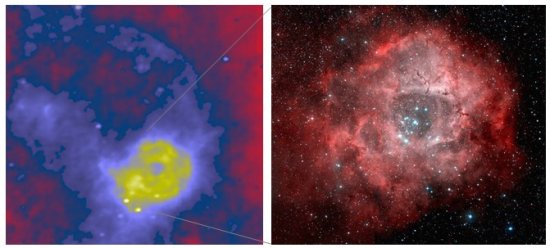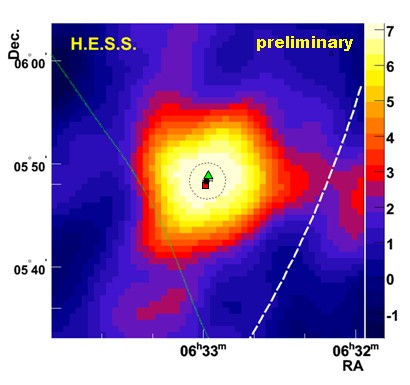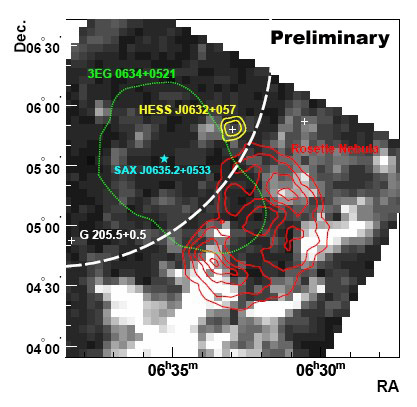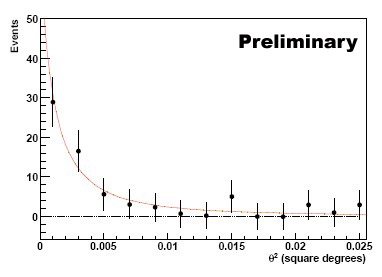A Point-Like Gamma-Ray Source in Monoceros
February 2007

Previous H.E.S.S. results on the supernova remnants RX J1713.7-3946 and RX J0852.0-4622 have clearly demonstrated that supernova shock fronts are capable of accelerating particles to very high energies. Gamma rays are produced when the primary accelerated nuclei collide with ambient gas, and the rate of gamma rays grows with the amount or density of target gas. For this reason, supernova remnants expanding into and colliding with molecular clouds are expected to be copious sources of gamma rays. The Monoceros supernova remnant (G205.5+0.5), at a distance of about 5000 light years, is believed to interact with the Rosette Nebula - a young stellar cluster / molecular cloud complex - and is therefore an obvious target for very high-energy gamma ray observations. Earlier HEGRA observations of the region, however, did not expose any gamma-ray sources (Aharonian et al. 2004).
The Monoceros/Rosette Nebula region was target of H.E.S.S. observations between 2004 and 2006, as part of the scan of the Galactic plane. In these data, a gamma-ray source just north of the Rosette Nebula is visible, with a statistical significance of 7 standard deviations (Fig. 1 and Fig. 2). The object is just off the top edge of the image of the Rosette Nebula shown above and therefore probably not directly related to the nebula. What makes this source - termed HESS J0632+057 - rather special that unlike virtually all other Galactic sources it appears pointlike, with an upper limit on its rms size of 2' (Fig. 3). The flux of the source is about 3% of the Crab Nebula flux and the spectrum is consistent with a power law with a photon index around 2.5, like many other Galactic objects.
What is this source? If related to particles accelerated in the Monoceros supernova remnant, a compact high-density gas cloud would be required to create a point-like gamma-ray source. NANTEN CO observations of the region (Fig. 2), however, show no indications for a molecular cloud coincident with the gamma-ray source. A very faint ROSAT X-ray source, 1RXS J063258.3+054857, is within errors coincident with the gamma-ray source (Fig. 1), but has an X-ray energy flux which is small compared to the gamma-ray energy flux. A common electron origin would require either very low magnetic fields, suppressing X-ray emission, or strong X-ray absorption, or a very special electron energy spectrum emphasizing the energy range responsible for Inverse-Compton up-scattering. A potential counterpart is also a massive Be-type star, HD 259440 (or MWC 148); with strong stellar winds and a high mass-loss rate such stars are good candidates for particle acceleration in shocks in the wind, a mechanism already discussed in the context of the source HESS J1023-575.
References:
H.E.S.S. collaboration, F. Aharonian et al., in preparation


